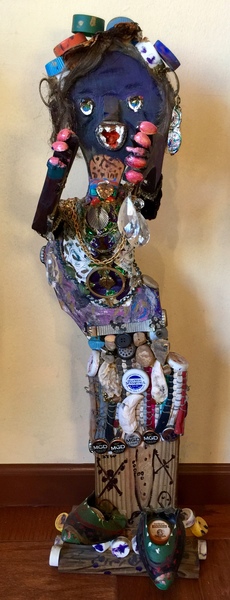Encountering an Extraordinary Caribbean Artist in Chicago
4/29/2018

I met Derek Webster by accident in 2001 when I got lost driving around South Chicago and made a wrong turn. It wasn’t supposed to happen that way. I had just seen some of his astonishing works in a private collection in a Chicago suburb and had asked for his address. This was pre-GPS and internet searches were only an afterthought. My only tool was a AAA paper map, and this address was not on it. It was obviously beyond the official city limits. But I had a phone number. I told my husband we had to meet this artist. We were staying in Evanston for a month while my husband was a visitor at Northwestern University. So we agreed to call just before the following weekend to see if we could arrange a visit.
Meanwhile the next day I had a different mission. I wanted to see the famous Pullman murals in South Chicago. A very long drive and many many detours (due to road repairs) later, I was completely lost and decided to give up. I turned the car around. I had a general idea of how to get back to Chicago, and to Evanston. I was now driving through a working class neighborhood of modest bungalows. Stopping at a red light I saw something absolutely astonishing out of the corner of my eyes. In a few seconds I took in that little corner house with its garden. It was completely different from all the others. There were colorful figures dancing along the fence- no, wait, they WERE the fence! The mailbox in front was encrusted with shiny objects and looked nothing like a mailbox. And, wait, was that a bottle tree in the yard? I pulled over, parked in front of the house, wondering what to do next. I looked at the street name. I pulled out a little piece of paper from my wallet and I realized I was now standing in front of Derek Webster’s house. I rang the bell and there he was, a tall African American man. Come in, he said, and invited me into his world. A few days later I came back with my husband. We were stunned by what we saw, and by the story of this extraordinary artist.
Born in Honduras in 1934 and raised in Belize, Derek Webster moved to the United States in 1964 after having traveled the Caribbean and Africa for years, working on ships. He settled in Chicago where he eventually managed to buy this small house on the outskirts of the city. In order to distinguish it from neighboring houses, he began building a fence of colorful figures reminiscent of West Indian Carnival dancers, many of them black, made of wood, custom jewelry, broken watches and found materials collected in Chicago’s back alleys. His janitorial job at a hospital provided him with colorful objects like bottles and caps, and the wood he needed was driftwood from the shores of Lake Michigan where Webster loved to fish. From embellishing his fence he turned to making individual figures and fantastic assemblages often inspired by his memories of Belize and the Caribbean.
Webster worked in the basement of his home, in a tiny space next to the boiler, surrounded by flamboyant totems, dancing ladies, and mystery figures. “Art critics tell me that my art is African,” he once told an interviewer, “but I don’t believe it. I have a gift, and they [the figures] just come out of me….Ideas came to me about how to decorate a yard. I could see the figures in my mind. I just went down in the basement and began making them.” - Derek Webster died in Chicago in 2009.
A recent solo exhibition of Webster’s art took place in Washington, D.C. in 2017: The Backyard of Derek Webster’s Imagination, at the Anacostia Community Museum (ACM) of the Smithsonian. http://www.eastcityart.com/reviews/derek-webster-garden-dream/
Please see works by this artist on this website.


